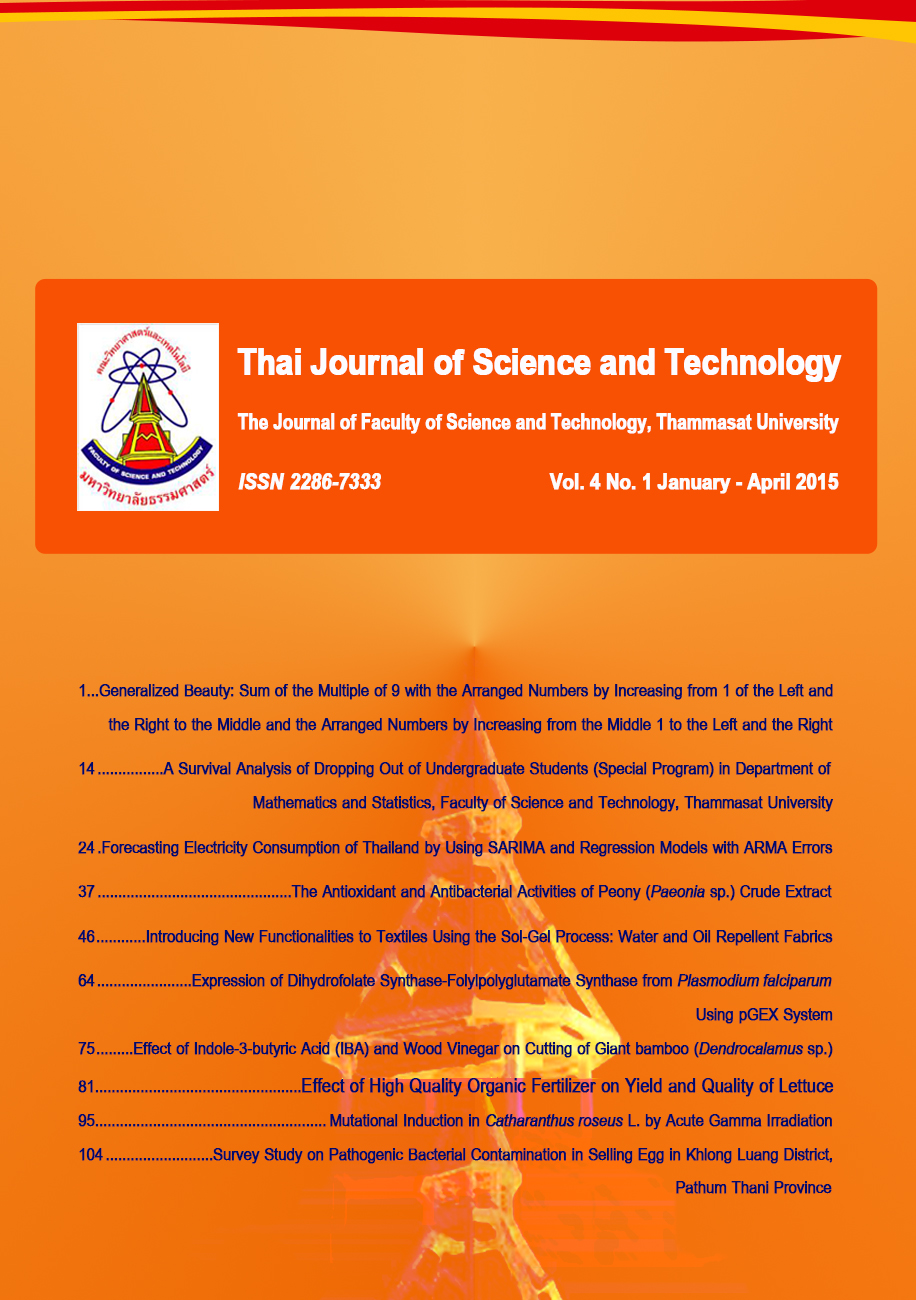การใช้กระบวนการโซลเจลเพื่อเพิ่มสมบัติของสิ่งทอ : ผ้าสะท้อนน้ำและน้ำมัน
Main Article Content
Abstract
บทคัดย่อ
การดัดแปรพื้นผิวผ้าให้มีสมบัติที่ดีขึ้นหรือเพิ่มสมบัติพิเศษใหม่ ๆ สามารถทำได้โดยง่ายด้วยกระบวนการโซลเจล ได้แก่ การดัดแปรผ้าธรรมดาให้แสดงสมบัติสะท้อนน้ำ น้ำมัน และคราบสกปรก ผ้าที่ได้จึงสามารถซักทำความสะอาดได้ง่าย เหมาะกับการใช้งานทั้งเป็นเครื่องนุ่งห่มหรือใช้ในงานเฉพาะด้าน นอกจากนี้ การเคลือบผิวผ้าด้วยกระบวนการโซลเจลยังปรับให้เข้ากับเทคโนโลยีการตกแต่งสำเร็จทั่วไปในอุตสาหกรรมสิ่งทอได้ เช่น การจุ่มเคลือบ การจุ่มอัด การสเปรย์ วิธีการเคลือบพื้นผิวให้มีสมบัติสะท้อนน้ำหรือน้ำมันจะต้องใช้สารเคลือบผิวที่มีองค์ประกอบเป็นสารไม่ชอบน้ำ คือ มีองค์ประกอบเป็นหมู่อัลคิลหรือฟลูออโร อัลคิล ซึ่งอาจเลือกสารเคมีที่มีโครงสร้างดังกล่าวผสมกับสารตั้งต้นในกระบวนการโซลเจล โดยให้เกิดพันธะโคเวเลนต์ระหว่างกัน หรืออาจผสมเป็นสารเติมแต่งที่จะฝังติดอยู่ในชั้นสารเคลือบผิวด้วยแรงทางกายภาพ สารตั้งต้นที่ใช้ในกระบวนการโซลเจลมีมากมาย แต่ในที่นี้จะกล่าวถึงเพียงกลุ่มสารอัลคอกซีไซเลนที่ใช้กันแพร่หลายเท่านั้น บทความนี้ได้รวบรวมวิธีการดัดแปรผ้าให้มีสมบัติสะท้อนน้ำและน้ำมันด้วยกระบวนการโซลเจล ตลอดจนข้อได้เปรียบและข้อจำกัดของกระบวนการนี้เมื่อเทียบกับเทคโนโลยีการเคลือบผิวอื่น ๆ
คำสำคัญ : กระบวนการโซลเจล; สิ่งทอ; ผ้าสะท้อนน้ำและน้ำมัน
Abstract
Modification of textile surfaces with sol-gel coatings allows improvements to be attained and the creation of new materials with novel properties. Conventional textiles can be easily modified via a sol-gel process to produce water-repellent, and water- and oil-repellent easy-to-clean fabrics suitable for clothing and other technical applications. Sol-gel finishing of textiles can be carried out by employing techniques conventionally used in the textile industry such as dipping, padding, and spraying processes. Hydrophobic or oleophobic surfaces can be generated by introducing alkyl-, or fluoroalkyl groups into the coating materials either via covalent bonding between the hydrophobic components and the inorganic building blocks, or physical embedding of hydrophobic additives into the sol-gel networks. Although a huge number of potential sol-gel precursors exists, only the alkoxysilanes are discussed here due to their widespread uses. This review provides an overview of sol-gel coatings for the textile industry as well as their benefits and limitations in comparison with other current surface coating processes.
Keywords: sol-gel process; textile; water and oil repellent fabric
Article Details
บทความที่ได้รับการตีพิมพ์เป็นลิขสิทธิ์ของคณะวิทยาศาสตร์และเทคโนโลยี มหาวิทยาลัยธรรมศาสตร์ ข้อความที่ปรากฏในแต่ละเรื่องของวารสารเล่มนี้เป็นเพียงความเห็นส่วนตัวของผู้เขียน ไม่มีความเกี่ยวข้องกับคณะวิทยาศาสตร์และเทคโนโลยี หรือคณาจารย์ท่านอื่นในมหาวิทยาลัยธรรมศาสตร์ ผู้เขียนต้องยืนยันว่าความรับผิดชอบต่อทุกข้อความที่นำเสนอไว้ในบทความของตน หากมีข้อผิดพลาดหรือความไม่ถูกต้องใด ๆ


